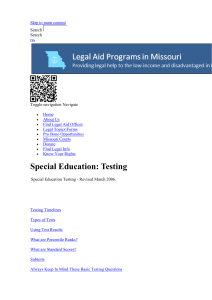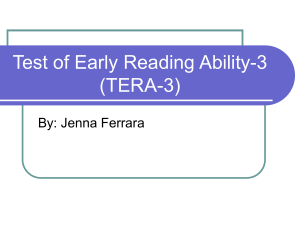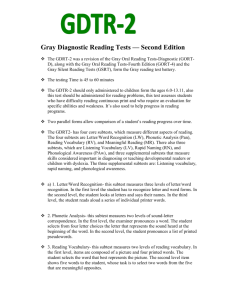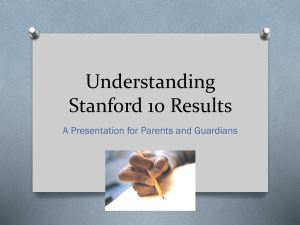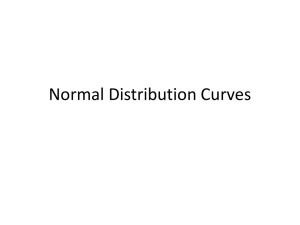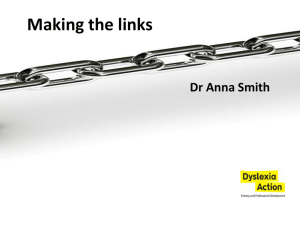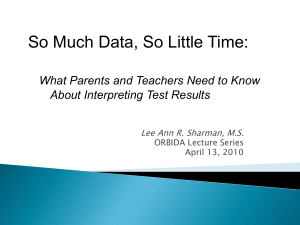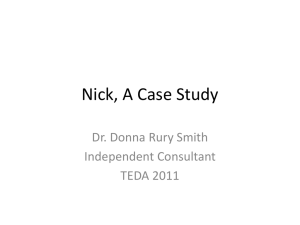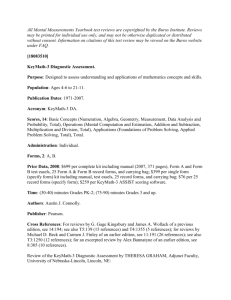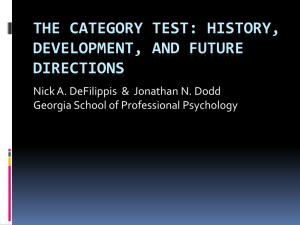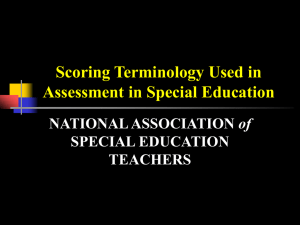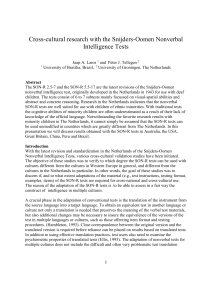Processing Speed - Idaho Training Clearinghouse
advertisement
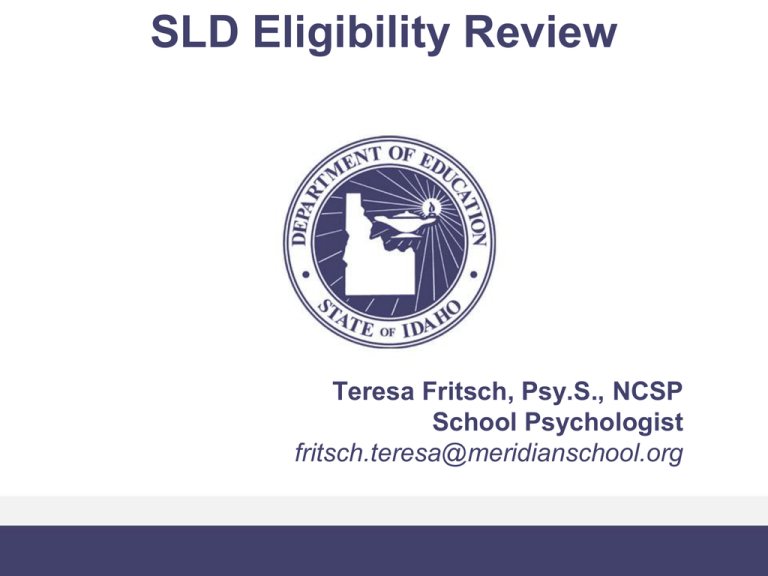
SLD Eligibility Review Teresa Fritsch, Psy.S., NCSP School Psychologist fritsch.teresa@meridianschool.org Purpose and Objectives • Review SLD Evaluation Procedures • Psychological Processing Models Review from Psychological Processing: Part 1 Webinar • Universal screening and data collection • Interventions provided to those students struggling and below grade level • Progress monitoring and data collection • Referral to consider special education evaluation Academic Achievement Assessment * Evidence of low achievement * Performance significantly below the mean on a cluster, composite, or 2 or more subtests in the same academic area (i.e. Word Attack and Letter-Word Identification=Basic Reading Skills) * Specific Learning Disability – not using Broad scores * Norm-referenced, standardized, achievement assessment Psychological Processing Review Con’t • Psychological Processing evaluation – Review and analyze all data already obtained (Teacher and Parent input from referral meeting) – Develop a theory and hypothesis – Assess/Collect data and interpret results – Determine if there is a link between psychological processing area(s) and academic deficits – Pattern of strengths and weaknesses – Do the dots connect? Sample SLD Eligibility Report Section A: Do Any One of the Following Factors Contribute to the Student’s Learning Difficulty? Directions: Please complete this section by carefully reviewing items 1 through 5 prior to considering SLD eligibility. Place a check in the box marked “yes” or “no”. If “yes” was checked in items 1 through 5, use the text box provided below to provide additional narrative information. 1. A visual, hearing or motor impairment Yes No 2. Cognitive impairment Yes No 3. Emotional disturbance Yes No 4. Environmental or economic disadvantage Yes No 5. Cultural factors Yes No For any of the above factors marked “yes”, describe how the student’s performance is impacted and indicate if this factor is a primary factor in the student’s learning difficulty. Academic Area(s) of Concern Directions: Place an “X” in the space below for each area of academic concern. Basic Reading Skills Oral Expression Written Expression Math Calculation Reading Comprehension Reading Fluency Listening Comprehension Math Problem Solving 1. Information shared by the parent(s) Directions: In the text boxes below, describe the student’s strengths and weaknesses as related to the area of concern that were shared by the parent(s). Student Strengths: Student enjoys reading for fun and likes to do his math homework first thing. Student Needs: Student hates to write and it’s like pulling teeth to get him to do any writing homework at home. He is a terrible speller and half the time I’m not sure what he’s trying to tell me when he leaves a note. 4. Data that establishes that the core curriculum is effective for most students. Directions: For each of the assessments, list the percentage of students within the student’s grade level who met grade-level performance benchmarks (may include ISAT, IRI, Grade Level Curriculum Based Measures, other measures). Name of Assessment Area Assessed Date Performance Benchmark Percentage of Grade Level Peers Meeting Performance Benchmark ISAT Language Usage 05/13/10 214 (Proficient) 79 AIMSweb Correct Writing Sequence (CWS) 09/2010 43 (50 percentile) th 83 Percentage of Disaggregated Group Level Peers Meeting Performance Benchmark (if applicable) Target Student Performance Level 202 (Below Basic) th 24 (16 percentile) 5. Document information that the student was provided with appropriate instruction in the general education setting by qualified personnel prior to or as a part of the referral process in the academic area(s) of concern. Core Instruction Provided Duration Academic Area EnglishWriting (7) EnglishWriting (6) Core Instruction Write Source 2000 (Great Source); Write Traits (Great Source); Step Up to Writing (Sopris West); Houghton Mifflin Write Source 2000 (Great Source); Step Up to Writing (Sopris West); Houghton Mifflin Total (weeks) Frequency (how often per week) Intensity (minutes per session) 02/15/11 20 weeks 5 times/week 45 minutes 06/08/10 36 weeks 5 times/week 45 minutes Begin Date (M/D/Y) End Date (M/D/Y) 08/31/10 08/31/09 Intervention Provided Academic Area of Concern Expressive Writing Intervention Learning Lab during which Student was pre-taught and retaught writing strategies using Step Up to Writing and Write Traits. Practice spelling tests using Spelling and Vocabulary (Houghton Mifflin). Direct instruction and practice on selfediting and use of graphic organizers. Begin Date (M/D/Y) 08/31/09 Duration End Date (M/D/Y) 02/15/11 Total (weeks) 56 weeks Frequency (how often per week) Intensity (minutes per session) 5 times/week 45 minutes 6. Data-based documentation of repeated assessments of achievement at reasonable intervals, reflecting formal assessment of student progress during instruction and intervention for each academic area of concern. For students who are culturally diverse and/or English Learners, progress documenting the student’s growth should be also compared against their subgroup’s progress Attach to the evaluation report, a copy of the student’s progress monitoring graph for each academic area of concern. The graph(s) must include the aimline, trendline, decision points, student’s rate of improvement, and national or local norm for grade level peers. For culturally diverse and English Learners, include comparisons to peer group progress. Summary of the data demonstrating the student’s progress during instruction and intervention in the academic areas of concern: Student has participated in a general education English 7 class all year as well as a Learning Lab class for point of need instruction. Student has been progress monitored in the area of written expression, particularly Correct Writing Sequences (CWS), with AIMSweb probes. The student’s last three scores were 21, 19, and 33 CWS, which is at the 7th percentile (median). The 50th percentile for 7th graders in the spring is a CWS score of 52. Student’s current average rate of improvement is -.01 CWS per week, which is below his expected growth of .50 per week. Student started off the year on track to make the goal but has plateaued over the last couple of weeks. The Team will use test results information to intensify or change the current interventions. Directions: Mark the area(s) of concern with an “X” and provide evidence of low achievement. Complete the table by providing specific assessment information as requested in the table for each are marked with an “X”. Basic Reading Skills Oral Expression Written Expression Math Calculation Reading Comprehension Reading Fluency Listening Comprehension Math Problem Solving Area of Concern Written Expression Date Name of Assessment 04/11/11 Woodcock Johnson III Tests of Achievement Subtest(s)/Composite/ Cluster Written Expression = SS %ile 78 7 Evaluator/Title Ms. Educator/ Special Education Teacher Description of assessment measure, validity statement, and interpretive information: The Woodcock Johnson III Tests of Achievement is an individually administered academic assessment for individuals between the ages of 2 to 90 years. The Written Expression cluster is composed of two subtests Writing Fluency and Writing Samples. Student scored below average on both subtests with a standard score of 80 (at the 9th percentile) on the Writing Fluency subtest and a standard score of 74 (at the 4th percentile) on the Writing Samples subtest. His overall Written Expression skills were below average with a standard score of 78 (at the 7th percentile). He was tested in a quiet room, free from distractions and he was on task and engaged during testing. He asked questions to clarify directions as needed. The scores can be considered a valid assessment of Student's current performance. Area of Concern Written Expression Date Name of Assessment Subtest(s) SS %ile 02/8/11 Test of Written Language-Fourth Edition (TOWL-4) Contrived Writing = Spontaneous Writing = Overall Writing = 84 93 89 14 32 23 Evaluator/Title Ms. Educator/Special Education Teacher Description of assessment measure, validity statement, and interpretive information: The TOWL-4 is a sevensubtest, norm-referenced measure used to assess written expression for students between the ages of 9 to 17 years. Student shows relative strengths in his Spontaneous Writing, which are his skills in style, contextual conventions, and story composition, and in the Average range. His greatest difficulties were in the Contrived Writing, which includes vocabulary, paragraph and sentence structure, capitalization, spelling and punctuation, and is Below Average. His overall writing on the TOWL-4 is within the low average range with difficulties noted in contrived writing. Based on his performance on both assessments, Student has a significant weakness in spelling, conventions (capitalization and punctuation), and sentence structure which correlate with the Contrived Writing assessment of the TOWL-4. Student demonstrated on-task behaviors and put forth good behavior on all tasks given to him for both assessment measures. Test results are considered valid. Various Models/Approaches to SLD Identification: - Discrepancy-Consistency Approach Using PASS Theory (Naglieri, Das, & Kirby)* - RTI & Cognitive Hypothesis Testing (ConcordanceDiscordance Model) (Hale, Wycoff, & Fiorello)* - Ability-Achievement Consistency Model (CHC Theory) (Flanagan, Alfonso, & Mascolo)* - Milton Dehn Model (Dehn) * Essentials of Specific Learning Disability Identification, 2011 Discrepancy-Consistency Approach Significant Difference(s) Processing & Achievement Strengths Achievement Weakness(es) Significant Difference(s) Processing Weakness(es) Similar Scores Copyright Jack A. Naglieri, 2010 RTI and Cognitive Hypothesis Testing Theory 1. Problem 5. Cognitive Strengths/Weaknesses 9 . Intervention Consultation 13. Continue/Terminate/Modify Hypothesis Interpretation 2. Intellectual/Cognitive Problem 6. Choose Related Construct Test 10. Choose Plausible Intervention 4. Interpret Psych. Processing 8. Interpret Constructs/Compare 12. Determine Intervention Efficacy Data Collection 3. Administer/Score Intelligence Test 7. Administer/Score Related Construct Test 11. Collect Objective Intervention Data Hale, J.B., & Fiorello, CA (2004) Ability Achievement Consistency Model (Cattell-Horn-Carroll Theory) • Level I-A: Measurement of Specific Academic Skills & Acquired Knowledge – Inter-Academic Ability Analysis (Stores of Acquired Knowledge) • Math Calculation - Basic Reading Skills - Reading Fluency • Math Reasoning - Reading Comprehension - Written Expression • General information* - Oral Expression* • Lexical Knowledge*- Listening Comprehension* • Level I-B: Evaluation of Exclusionary Factors – NOT Sensory Impairment; NOT Mental Retardation; NOT Cultural Differences; NOT Language Differences; etc… Flanagan et al (2002, 2006, 2007) Ability Achievement Consistency Model (Cattell-Horn-Carroll Theory) • • • • Level II-A: Measurement of Broad Abilities/Processes and Aptitudes for Learning-Inter-Cognitive Ability Analysis (Learning Efficiency) • Gt, Gs, Gsm, Glr, Ga, Gv, Gf, and Gc* Level II-B: Re-evaluation of Exclusionary Factors Level III: Evaluation of Underachievement – Integrated Ability Analysis • Below Average Aptitude-Achievement Consistency within an otherwise normal ability profile Level IV: Evaluation of Interference with Functioning (deficits are normative) • The identified deficits significantly interfere with academic achievement or other daily activities requiring these skills (e.g., reading, writing, math) Evidence of a Processing Strength or Weakness Milton J. Dehn, Ed.D. Spring 2010 • Both intra-individual and normative scores to be considered a strength or weakness •A low score in a process is not necessarily a deficit indicative of LD, unless it’s also an intra-individual weakness –Example: very low IQ have inherent processing problems –Although Dehn defines intra-individual and normative scores by certain values, the Idaho SLD policy looks for the preponderance of evidence to support the eligibility decision. Process Test/Battery Name Subtest/Factor Name Subtest Scores Factor Score IQ/Mean Difference From Mean Normative S or W Ipsative S or W **Information regarding the directions for the Processing Analysis Worksheet can be found in Dr. Dehn’s book. Deficit or Asset Basic Reading Skills Reading Comprehension Reading Fluency Math Math Calculation Problem Solving Written Expression Crystallized Intelligence Crystallized Intelligence Perceptual Speed Fluid Reasoning Fluid Reasoning Crystallized Intelligence Auditory Processing Short Term/Working Memory Long-Term Storage Crystallized Intelligence Crystallized Intelligence Short Term/Working Memory Long-Term Storage & Retrieval Long-Term Storage & Retrieval Phonological Processing Short-Term/ Working Memory Short Term/Working Memory Processing Speed Processing Speed Fluid Reasoning Crystallized Intelligence Processing Speed Processing Speed Fluid Reasoning Short-Term/ Working Memory Auditory Processing Visual Processing Visual Processing Attention Executive Function Flanagan, Ortiz, & Alfonso, 2007, Dehn, M., 2009, and McGrew 2009 Auditory Processing Section D: Pattern of Strengths and Weaknesses in Psychological Processing Skills That Impact Learning Processing Area Short-Term/ Working Memory (Gsm) Date Name of Assessment 02/02/11 Wide Range Assessment of Memory and Learning-Second Edition (WRAML-II) Composite/Cluster/ Subtest Verbal Memory = Visual Memory = Attention/Concentration= General Memory = Working Memory = SS %ile Evaluator/Title 88 91 88 85 83 21 27 21 16 13 Mrs. Helpful/School Psychologist 02/09/11 Woodcock Johnson III Tests of Cognitive Working Memory = 78 7 Abilities Description of assessment measure, validity statement, and interpretive information: The WRAML-2 is an individually administered assessment for individuals between the ages of 5 and 85+ years and is used to measure various aspects of a student's memory and learning. Student shows average skills on both subtests for Visual Memory with a scaled score of 9 on Design Memory and a scaled score of 8 on Picture Memory. On the Verbal Memory subtests, Student shows average skills on the Story Memory subtest with a scaled score of 9 but more difficulties with the Verbal Learning with a scaled score of 7, with an overall Verbal Memory score in the Low Average range. Student's memory span (Attention/Concentration) is also within the Low average range with a standard score of 88, which is at the 21st percentile. Student shows much stronger recognition abilities with scores all within the Average range, standard scores of 96, which are at the 39th percentile. His scores on the Working Memory subtests were split with stronger skills noted on the Verbal Working Memory subtest than on the Symbolic Working Memory subtest. Similar results were seen on the WJ III COG's Working Memory subtests. The Working Memory aspects of the Woodcock Johnson III Tests of Cognitive Abilities (WJ III COG) refer to the ability to hold information in immediate awareness while performing a mental operation on the information. The two subtests that comprise this cluster area are Numbers Reversed and Auditory Working Memory. Student scores significantly higher on the Auditory Working Memory subtest (standard score of 90) than he does on the Numbers Reversed subtest (standard score of 74). The discrepancy in these scores is very similar to the discrepancy noted above with the WRAML-2 subtests of working memory, which indicate that Student struggles significantly with the aspects of working memory which are more random, non-meaningful, and smaller in units. These working memory deficits have a direct correlation with the difficulties Student is having in his written expression, particularly with the mechanics and conventions of writing. Student put forth good effort on both tests and was very thoughtful in his responses; therefore test results are considered valid. Processing Area Crystallized Intelligence (Gc) Date Name of Assessment 02/09/11 Woodcock Johnson III Tests of Cognitive Abilities Composite/Cluster/ Subtest Comprehension/ Knowledge = SS %ile Evaluator/Title 92 31 Mrs. Helpful/School Psychologist Description of assessment measure, validity statement, and interpretive information: The ComprehensionKnowledge aspect of the WJ III COG refers to the breadth and depth of a student's acquired knowledge of a culture and the effective application of this knowledge. There are two subtests that comprise the Comprehension-Knowledge cluster of the WJIII and they are Verbal Comprehension (measures lexical knowledge) and General Information (range of general knowledge); Student scores similarly on both subtests with a standard score of 93 on Verbal Comprehension and 92 on General Knowledge. Student’s overall Comprehension-Knowledge standard score is a 92, which is at the 31st percentile and in the Average range. Student worked cooperatively and politely with this examiner throughout the entire evaluation; therefore test results are considered valid. Processing Date Name of Assessment Composite/Cluster/ SS %ile Evaluator/Title Area Subtest Auditory/ 02/09/11 Woodcock Johnson III Phonemic Awareness = 110 74 Mrs. Helpful/School Phonological Tests of Cognitive Psychologist Processing Abilities (Ga) Description of assessment measure, validity statement, and interpretive information: The Phonemic Awareness cluster of the WJIII COG includes the knowledge and skills related to analyzing and synthesizing speech sounds and consist of two auditory processing subtests - Sound Blending and Incomplete Words. Student scores within the high average and average range on both of these subtests, with stronger skills noted in Sound Blending (standard score of 114; 82nd percentile) than in Incomplete Words (standard score of 95; 38th percentile). His overall score in this cluster area is within the High Average range, with a standard score of 110 (74th percentile). Student listened carefully to each prompted and was very thought in his responses; test results are considered valid. Processing Area Processing Speed (Gs) Date Name of Assessment 02/09/11 Woodcock Johnson III Tests of Cognitive Abilities Composite/Cluster/ Subtest Processing Speed = SS %ile Evaluator/Title 83 13 Mrs. Helpful/School Psychologist Description of assessment measure, validity statement, and interpretive information: The Processing Speed parts of the WJ III measures an individual’s ability to perform automatic cognitive tasks, particularly when measured under pressure to maintain focused attention. Student struggled on both subtest related to Processing Speed – Visual Matching and Decision Speed – with standard scores in the Below Average range (84 and 81, respectively). His overall processing speed ability is within the Below Average range indicating a normative weakness in this area. Processing Speed does have a direct correlation to written language skills; therefore Student’s difficulties in this psychological processing area are directly impacting his expressive writing skills. Student put forth good effort on both subtests; therefore test results are considered valid. Processing Date Name of Assessment Composite/Cluster/ SS %ile Evaluator/Title Area Subtest Fluid Reasoning (Gf) 02/09/11 Woodcock Johnson III Tests of Cognitive Abilities Fluid Reasoning = 97 41 Mrs. Helpful/School Psychologist Description of assessment measure, validity statement, and interpretive information: Fluid Reasoning of the WJ III COG refers to mental operations that a student uses when faced with a relatively novel task that cannot be performed automatically. There are two subtests that make up the Fluid Reasoning cluster of the WJ III, and they are Concept Formation and Analysis-Synthesis. Student scores were similar on these two subtests with a standard score of 93 at the 32nd percentile on Concept Formation and a standard score of 102 at the 55th percentile on AnalysisSynthesis. Student's overall score in Fluid Reasoning is within the Average range, with a standard score of 97, at the 41st percentile. He put forth good effort on all tasks given to him demonstrating average energy and attention. Test results are considered valid. Key Elements of Psychological Processing: * Pattern of Strengths and Weaknesses * Normative Weaknesses must link to academic deficits * Summarize information in Section G; bring the story together; connect the dots www.idahotc.com Training and Technology for Today’s Tomorrow • Supported By: • Website to link school professionals and parents with special education training opportunities and resources across the state – Idaho State Department of Education (ISDE), Special Education • Project Team: – Cari Murphy – Shawn Wright Statewide Special Education Technical Assistance (SESTA) Center for School Improvement & Policy Studies, BSU Gina Hopper, Associate Director ginahopper@boisestate.edu 208.426.4363 Carol Carnahan, Statewide Consultant carolcarnahan@boisestate.edu 208.426.3257 www.sde.idaho.gov/site/isee Contact Us Teresa Fritsch, School Psychologist, Meridian School District, fritsch.teresa@meridianschools.org Carol Treat, School Psychologist, Post Falls School District, ctreat@sd273.com Richard Henderson, Director of Special Education, SDE, rhenderson@sde.idaho.gov
